Related Research Articles

Ozaukee County is a county in the U.S. state of Wisconsin. As of the 2020 census, the population was 91,503. Its county seat is Port Washington. Ozaukee County is included in the Milwaukee–Waukesha–West Allis, WI Metropolitan Statistical Area.

Mequon is the largest city in Ozaukee County, in the U.S. state of Wisconsin, and the third-largest city in Wisconsin by land area. Located on Lake Michigan's western shore with significant commercial developments along Interstate 43, the community is a suburb in the Milwaukee metropolitan area. Despite being an incorporated city, approximately half of Mequon's land is undeveloped and agriculture plays a significant role in the local economy. At the time of the 2020 census the population was 25,142.

Thiensville is a village in Ozaukee County, Wisconsin, United States. Located on the west bank of a bend in the Milwaukee River, the community is bordered on all sides by the City of Mequon and is a suburb in the Milwaukee metropolitan area. The population was 3,235 at the 2010 census.

Cedarburg is a town in Ozaukee County, Wisconsin, United States, and is in the Milwaukee metropolitan area. The town was created in 1849 and at the time of the 2020 census had a population of 6,162.

Cedarburg is a city in Ozaukee County, Wisconsin, United States. Located about 20 miles (32 km) north of Milwaukee and in close proximity to Interstate 43, it is a suburban community in the Milwaukee metropolitan area. The city incorporated in 1885, and at the time of the 2020 census the population was 12,121.
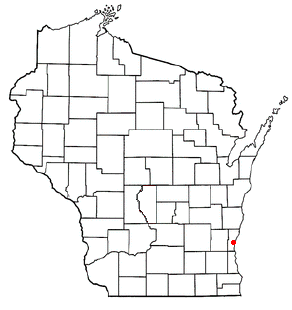
The Town of Grafton is a town located in Ozaukee County, Wisconsin, United States, and is in the Milwaukee metropolitan area. The town was created in 1846 and at the time of the 2020 Census had a population of 4,157.

Grafton is a village in Ozaukee County, Wisconsin, United States. Located about 20 miles (32 km) north of Milwaukee and in close proximity to Interstate 43, it is a suburban community in the Milwaukee metropolitan area. The village incorporated in 1896, and at the time of the 2020 census the population was 12,094.
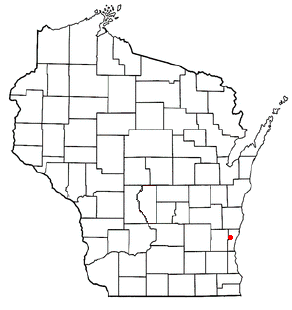
Saukville is a town in Ozaukee County, Wisconsin, United States. The Village of Saukville is located in the town's southeast quadrant. The population was 1,755 at the 2000 census.
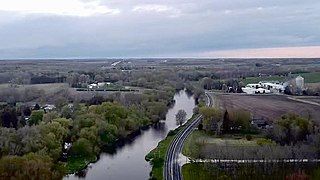
Saukville is a village in Ozaukee County, Wisconsin, United States. Located on the Milwaukee River with a district along Interstate 43, the community is a suburb in the Milwaukee metropolitan area. The population was 4,258 at the 2020 census.

This is a list of the National Register of Historic Places listings in Ozaukee County, Wisconsin. It is intended to provide a comprehensive listing of entries in the National Register of Historic Places that are located in Ozaukee County, Wisconsin. The locations of National Register properties for which the latitude and longitude coordinates are included below may be seen in a map.

Washington Avenue Historic District is the historic center of Cedarburg, Wisconsin, the location of the early industry and commerce that was key to the community's development. The historic district was listed on the National Register of Historic Places (NRHP) in 1986.

The Cedarburg Mill is a former gristmill in Cedarburg, Wisconsin that is listed on the U.S. National Register of Historic Places. Located the on Cedar Creek, the building was constructed in 1855 by Frederick Hilgen and William Schroeder to replace a smaller wooden mill from the 1840s. At the time of its construction, the five-story structure was the tallest building in Cedarburg.

The Wayside House is a historic house located in Cedarburg, Wisconsin. It was built by Frederick Hilgen, who later co-owned the Cedarburg Mill, and is considered the father of Cedarburg. It was added to the National Register of Historic Places on March 17, 1982.
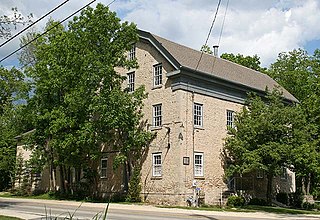
Hamilton is an unincorporated community located in the Town of Cedarburg, Ozaukee County, Wisconsin, United States. Much of the community is part of the Hamilton Historic District, a site listed on the National Register of Historic Places. The NRHP-listed Concordia Mill is also located in the community.
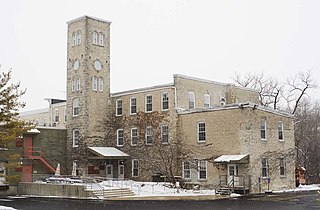
The Cedarburg Woolen Co. Worsted Mill is a former woolen mill on the Milwaukee River in Grafton, Wisconsin. In the late-1800s, the Cedarburg Woolen Company in neighboring Cedarburg decided to expand their production by opening a second mill.

The Hilgen and Wittenberg Woolen Mill is a former textile factory in Cedarburg, Wisconsin. Built in 1864, the mill was one of many wool- and flax-processing factories that opened during the American Civil War, due to a shortage of cotton textiles formerly supplied by southern states. The mill produced yarns, blankets, and flannels, and was the largest woolen mill west of Philadelphia in the 19th century. The mill closed in 1968 and has since become a commercial complex called the "Cedar Creek Settlement," containing restaurants and stores.

The Old Ozaukee County Courthouse in Port Washington, Wisconsin is a Richardsonian Romanesque-styled building built in 1901 and clad in gray-blue limestone from the nearby Cedarburg quarry. It was added to the National Register of Historic Places in 1976. The building currently serves as the county administration center.
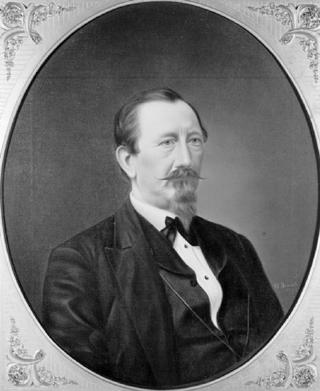
Frederick William Horn was a German-American immigrant, lawyer, politician, and Wisconsin pioneer. He served in many elected offices; he was the 4th, 7th, & 25th speaker of the Wisconsin State Assembly, and served a total of 14 years in the Assembly. He also served five years in the Wisconsin State Senate—including the first three sessions after statehood—and was the first mayor of Cedarburg, Wisconsin, serving seven years in that role. He generally identified as a Democrat, but was elected several times as an Independent.

The Columbia Historic District is a neighborhood in Cedarburg, Wisconsin, that is listed on the National Register of Historic Places. At the time the district was listed on the register, its contributing properties included 128 historic homes, one church, and eighty-seven historic outbuildings, including garages and barns, all constructed between 1844 and 1938. The district also contained several dozen buildings that do not contribute to the historic district, including modern homes from the post-war era as well as modern garages and other additions to historic properties.
Herman Joseph Schulteis was a German American immigrant, politician, and Wisconsin pioneer. He was a member of the Wisconsin Senate, representing Ozaukee County during the 1857 and 1858 sessions. His name was also sometimes incorrectly spelled "Schulties", "Schultes", or "Schultis".
References
- 1 2 3 4 5 6 7 8 9 Gierach, Ryan (2003). "Father Hilgen and Company". Cedarburg: A History Set in Stone. Arcadia Publishing. pp. 39–45. ISBN 0-7385-2431-X. LCCN 2003103136 . Retrieved May 3, 2023.
- 1 2 3 4 History of Washington and Ozaukee counties, Wisconsin. Western Historical Company. 1881. pp. 531–534.
- ↑ "N58 W6181 COLUMBIA (215 E COLUMBIA AVE)". Wisconsin Historical Society . January 2012. Retrieved May 3, 2023.
- ↑ Crane, L. H. D., ed. (1860). "Standing Committees of the Senate". A Manual of Customs, Precedents, and Forms, in Use in the Assembly of Wisconsin (Report). State of Wisconsin. p. 14 . Retrieved May 3, 2023.
- ↑ "N70 W6340 BRIDGE ST". Wisconsin Historical Society . January 2012. Retrieved May 3, 2023.
- ↑ "Hon. Frederick Hilgen". Janesville Daily Gazette . March 29, 1878. p. 1. Retrieved May 3, 2023– via Newspapers.com.
- 1 2 Wendt, Alice Schimmelpfennig (1988). Hilgen Heirs. A.S. Wendt.